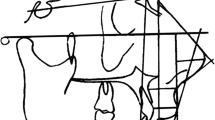Abstract
Primary aim
Variability is characteristic of different faces and facial types, and normative data based on one population group does not represent all. Hence, this study was undertaken to establish skeletal cephalometric norms for the South Indian (Karnataka) population utilizing the norms laid by Burstones’s analysis for Caucasians.
Methods
The sample comprised of lateral cephalograms taken in natural head position of 100 participants (50 men, 50 women). The cephalograms were traced, analyzed and interpreted using the landmarks and values given by Burstone’s analysis (Cephalometric analysis for Orthognathic surgery). The student’s t test, standard deviation and mean deviation were calculated to compare between two groups.
Results
Statistically significant skeletal differences were found between men and women of the South Indian origin in comparison to Caucasian origin. Men had decreased facial divergence, anterior maxillary dental height and proclined upper incisors. Women had marginally increased cranial base, increased midfacial height and proclined upper incisors.
Conclusion
Statistically significant differences were found between South Indian men and women when compared with Caucasians in certain key parameters. These differences need to be considered when analyzing the cephalogram for orthognathic surgeries. The values derived from this study may be considered to make the deformity assessment and plan surgery to get optimal results for people of south Indian origin conclusive results can be derived after conducting a study with an eager sample size.








Similar content being viewed by others
References
Bishara SE, Abdalla EM, Hoppens BJ (1990) Cephalometric comparisons of dentofacial parameters between Egyptians and North American adolescents. Am J Orthod Dentofacial Orthop 97(5):413–421
Cotton WN, Takano WS, Wong WMW (1951) The Downs analysis applied to three other ethnic groups. Angle Orthod 21(4):213–220
Hajighamidi M, Doughetry H, Garanki F (1981) Cephalometric evaluation of Iranian children and its comparison with tweeds and steiner’s standards. Am J Orthod 79(2):192–197
Kudhadkar A, Jayade VP (1997) Craniofacial morphology of an ethnic Tibetian population—a cephalometric evaluation. J Ind Orthod Soc 30:23–29
Engel G, Spolter BM (1981) Cephalometric and visual norms for a Japanese population. Am J Orthod 80(1):48–60
Iizuka T, Ishikawa F (1957) Normal standards for various cephalometric analysis in Japanese adults. J Jpn Orthod Soc 16:4–12
Kayukava H (1954) Roentgenographic cephalometric craniofacial morphology of Japanese—part I; application of Down’s analysis. J Jpn Orthod Soc 13:6–17
Miura F, Inove N, Suzuki K (1963) The standard of steiners analysis for Japanese. Bull Tokyo Med Dent Univ 10:387–395 (Cited By Ueseto)
Alcalde RE, Jinno T, Pogrel MA, Matsumura T (1998) Cephalometric norms in Japanese adults. J Oral Maxillofac Surg 56(2):129–134
Shishikura K (1969) The study on measurements of hard and soft tissues by cephalogram, particularly on normal and class I occlusion among Japanese adults. J Jpn Orthod Soc 28(2):263–273
Chan GK (1972) Cephalometric appraisal of the Chinese. Am J Orthod 61(3):279–285
Cooke MS, Wei SH (1987) A Comparative study of Southern Chinese and British Caucasian cephalometric standards. Angle Orthod 59(2):131–138
Wu J, Hagg U, Rabie AB (2007) Chinese norms of Mcnamara’s cephalometric analysis. Angle Orthod 77(1):12–20
Jahanshahi M, Golalipour MJ, Heidari K (2008) The effect of ethnicity on facial anthropometry in northern Iran. Singapore Med J 49(11):940–943
Park IC, Bowman D, Klapper L (1989) A cephalometric study of Korean adults. Am J Orthod Dentofacial Orthop 96(1):54–59
Kotak VB (1964) Cephalometric evaluation of Indian girls with neutral occlusion. J Indian Dent Assoc 183–197
Nanda R, Nanda RS (1969) Cephalometric study of the dentofacial complex of North Indians. J Indian Dent Assoc 39(1):22–28
Jalili VP, Shalkh HS (1984) Vertical dimensions of face and dentition—a cephalometric study. J Indian Dent Assoc 56(7):249–259
Valiathan A (1974) Down’s cephalometric analysis on adults from India. J Indian Dent Assoc 437–441
Joshi MR (1975) Dentofacial characteristics of a group of Gurkhas. J Indian Orthod Soc 7(4):3–12
Kannappan JG, Balasubramaniam MR (1976) Cephalometric norms for Madras city population. J Indian Dent Assoc 48:359–362
Kharbanda OP, Sidhu SS, Sundram KR (1989) Cephalometric profile of Aryo-Dravidians II. J Indian Orthod Soc 20(6):89–94
Grewal H, Sidhu SS, Kharbanda OP (1995) Cephalometric appraisal of the craniofacial pattern in Indo-Aryans. J Indian Orthod Soc 26:43–48
Bhat M, Sudha P, Tandon S (2001) Cephalometric norms for bunt and brahmin children of dakshina kannada based on Mcnamara’s Analysis. J Indian Soc Pedod Prev Dent 19(2):41–51
Tippu SR, Subramanium M, Rahman F, Akkera U (2007) Soft tissue cephalometric norms for orthognathic surgery in Indian adults. Int J Oral Maxillofac Surg 36(11):10–20
Burstone CJ, James RB, Legan H, Murphy GA, Norton LA (1978) Cephalometric for orthognathic surgery. J Oral Surg 36(4):269–277
Burstones CJ (1958) The integumental profile. Am J Orthod 44:1–25
Beugre JB, Sonan NK, Beugre-Kouassi AM, Djaha F (2007) Comparative cephalometric study of three different ethnic groups of black Africa with normal occlusion. Odontostomatol Trop 30(117):34–44
Jacobson A (1978) The craniofacial skeletal pattern of the south African Negro. Am J Orthod 73(6):681–691
Broadbent BH (1931) A new X-ray technique and its application to orthodontia. Angle Orthod 1:45–60
Kalhaa AS, Latif AB, Govardhan SN (2008) Soft tissue cephalometric norms in a South Indian ethnic population. Am J Orthod Dentofac Orthoped 133(6):876–881
Acknowledgement
I would like to thank Dr. K. Sadashiva Shetty, Principal, Bapuji Dental College and Hospital for the support, encouragement and permission to utilize the necessary facilities to conduct the study. I also take this opportunity to thank my wife Dr. Deepa D who has been active in completion of this article.
Author information
Authors and Affiliations
Corresponding author
Rights and permissions
About this article
Cite this article
Arunkumar, K.V., Reddy, V.V. & Tauro, D.P. Establishment of Cephalometric Norms for the South Indian (Karnataka) Population Based on Burstone’s Analysis. J. Maxillofac. Oral Surg. 9, 127–133 (2010). https://doi.org/10.1007/s12663-010-0039-2
Received:
Accepted:
Published:
Issue Date:
DOI: https://doi.org/10.1007/s12663-010-0039-2




